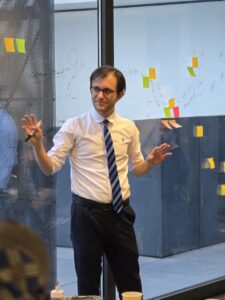Software is everywhere, quietly shaping the systems we rely on every day. I’ve spent over a decade immersed in this world, starting as a developer, then evolving into a designer of software that aims not just to function, but to solve real, meaningful problems. Along the way, I’ve learned that great software starts with asking better questions, not just writing better code.
This site is where I share what I’ve learned about domain modeling, software architecture, and problem discovery, share practical insights, and examine how software can be designed with greater precision and purpose. I write about patterns, principles, and practices like Language-Driven Design, Exploratory Domain Discovery, and Orbit Software Development.

Need Expert Technical Guidance?
Access top-level Fractional CTO services including architecture consulting, roadmap planning, team mentoring, and code review. Perfect for startups and growing teams.
Recent Works
There are threads I’m following, concepts growing quietly that may soon take a more public form.
Language-Driven Design
I’m currently working on Language-Driven Design, a book that explores a paradigm shift in how we model and design complex systems, by treating the language of the domain as the foundation of both understanding and architecture.
Exploratory Domain Discovery
Exploratory Domain Discovery is a method I’ve been developing to guide teams in navigating complex problem spaces, prioritizing deep understanding and adaptive modeling over premature precision.
Orbit Software Development
I’ve also been developing Orbit Software Development, an agile approach to building software that centers on evolving goals, continuous learning, and the natural alignment of teams, architecture, and intent.
New Published Patterns & Heuristics
A collection of newly documented design patterns, each distilled from real-world challenges and crafted to address recurring problems with clarity and precision.
State/Status Segregation Pattern
Design Pattern
This pattern advocates separating an entity’s transient state from its long-term status to clarify modeling and avoid ambiguity in domain behavior. download
Behavior as Data Pattern
Design Pattern
It encourages treating business behaviors as first-class data, enabling introspection, scheduling, and dynamic orchestration of logic. download
Sequencer Design Pattern
I’m pleased to introduce the Sequencer Pattern, a new design pattern I have formalized to model values that progress step-by-step within a set of boundaries. This pattern is a concept from my upcoming book, Language-Driven Design.
From the ticks of a clock to currency rollovers, animations, and simulations, this pattern gives a name and structure to something you’ve likely built many times before.
Read the full article and see the code examples here:
Mixed Responsibility Smell
Code Smell – Hubristic
This smell highlights the confusion and complexity that arises when a model or component takes on multiple, unrelated responsibilities.
Music
As an amateur musician, I enjoy composing and experimenting with sound, it’s a creative outlet that helps me think differently and reconnect with rhythm and emotion.
Listen to my Setar improvisation on SoundCloud👇🏻
Goal-Oriented Architecture
I explore architecture that begins with intent. In Goal-Oriented Architecture, software is shaped around the goals it exists to achieve, not just data structures or workflows. This perspective brings clarity, alignment, and purpose to system design, making every part of the codebase traceable to real-world outcomes.
Read more: Introducing Goal-Oriented Software ArchitectureDomain-Driven Design School
Eric Evans’ DDD has always been an inspiration and game changer for me. This book has played a huge role in shaping my mind as a software developer on how to think practically, effectively and constructively about this field, and sharpening my modeling and design lens in this field as a key driver of “discovering better ways to develop software”!
As a DDD expert and teacher, I launched DDD School as a startup to educate, consult and share my thoughts, learning and experience in modeling and designing software development
Language-Driven Design
I’ve been working on writing my book titled Language-Driven Design. At its core, the book explores the profound impact of language on how we think and perceive the world around us. This idea has deep roots in philosophy, particularly in the study of the relationship between language and thought. Language-Driven Design (LDD) emphasizes the central role language plays in how we understand, design, and architect software. It argues that the words we choose, both in code and in conversation, shape not only our solutions but also the way we conceptualize problems in the first place.
Exploratory Domain Discovery
Exploratory Domain Discovery (EDD), introduced by me, is a collaborative and powerful approach to understanding complex domains by exploring their core concepts and cyclical patterns.
Unlike traditional modeling techniques, EDD starts from the desired outcome and works backward to uncover the main point that drives the domain, enabling teams to build shared understanding and make strategic decisions with clarity.
-
Introducing Goal-Oriented Software Architecture
Abstract Goal-Oriented Software Architecture is a new architectural style that positions business intent as the primary structuring unit of a software system. It directly addresses the chronic misalignment between software structure and business intent, offering a radically different model where each business goal is encapsulated, executable, and traceable as a first-class citizen. This document outlines…
-
Zipf’s Law: A Universal Pattern in Our Data-Driven World
Introduction Have you ever wondered why some words appear far more frequently than others in a language? Or why a handful of cities dominate a country’s population? These seemingly disparate phenomena share a surprising commonality: they often follow a simple yet profound pattern known as Zipf’s Law. What is Zipf’s Law? Zipf’s law is an…
-
The Bandwagon Effect in Software Modeling
The Perils of the Bandwagon Effect in DDD from Wikipedia The bandwagon effect is a psychological phenomenon where people adopt certain behaviors, styles, or attitudes simply because others are doing so. Introduction The software development landscape is constantly evolving, with new technologies, frameworks, and methodologies emerging at a rapid pace. While innovation is essential, it’s…
-
Shedding Light on the Differences Between Test, Unit Testing, BDD, TDD and Acceptance Testing
Introduction There are many myths about *test-ish in software development. What is the essence of software testing? What is the purpose of a “unit testing”-kind of software testing? Should we consider this a “unit test” or an “integration test”? Why do we really need someone to replace the “T” in “TDD” with a “B” and…
-
The Mirroring Principle and Organization Structure
Intro The adage “as above, so below” finds a curious parallel in the realm of organizational structure and system design. The Mirroring Principle, often intertwined with Conway’s Law, posits that the structure of an organization directly influences the structure of the systems it produces. Conway’s Law is a well-known principle in software engineering that states:…
-
Code is Cheap, Describe It to Me: A New Paradigm in Software Development
Linus Torvalds’s intellectual framework The adage “Talk is cheap, show me the code” has long been a mantra in the software development world. It’s the Linus Torvalds way of going a way developers. It emphasizes the importance of tangible results over mere words. However, I have a new perspective, challenging this traditional notion: “Code is…
-
Software Architecture vs. Design Patterns
The Big Picture vs. the Details. Opening Words Building software is complicated. It needs careful planning to make sure it’s strong, easy to update, and can handle lots of users. Two important ideas are software architecture and design patterns. They’re both important, but they work at different levels. I will briefly outline my understanding of…
-
The Four Angles of Software Design- Language, Model, Domain Experts, and Code
Software Model is a constant conversation with domain experts and with code. DDD fundamentally centers around the model as the key to bridging the gap between a real-world problem and its software solution. In DDD, the model isn’t just a blueprint; it plays a crucial and active role throughout the entire design and development process. Crucially,…
-
Introducing Behavior as Data Pattern
When Data Becomes Behavior In my experience designing complex software systems, I frequently encountered challenges where changing a simple field value affected the overall behavior and logic of an object or module. Initially, these designs were data-driven, meaning those values were just stored as simple fields. Over time, as different behaviors were implemented based on those…
Tags
acceptance testing Bad Practice Bandwagon book code smell Code Structure Conway’s Law DDD Debt Design Pattern Epistemic Testing Experiment Goal Oriented Architetcure Idea LDD Minimum Viable Experience Orbit Organizational Structure Refactoring Social Rank Software Architetcure System Debt tdd Team Topology Tech Debpt Test test automation
